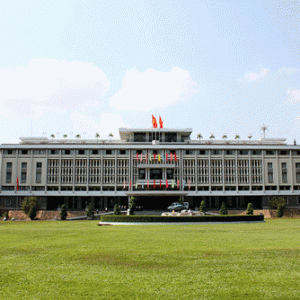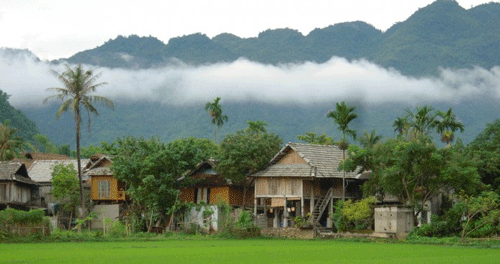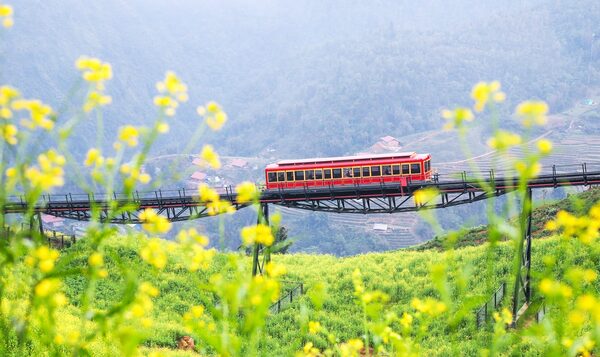Reunification Palace, formerly known as Independence Palace, is one of the most iconic landmarks in Ho Chi Minh City, Vietnam. This historic site is not just a building but a powerful symbol of Vietnam’s turbulent past. It marked the end of the Vietnam War when a North Vietnamese tank crashed through its gates on April 30, 1975. For travelers and history enthusiasts, visiting Reunification Palace in Ho Chi Minh City offers a deep dive into the nation’s history, architecture, and cultural significance. Join us to explore the palace’s history, unique design, must-see highlights, and practical visitor information to help you plan your trip.
Forfaits touristiques recommandés :- A Glimpse of Vietnam – Travel from Hanoi to Ho Chi Minh City in 8 Days
- World heritage sites in Vietnam – Ho Chi Minh City to Hanoi Tour in 8 Days
- Ho Chi Minh City and Cu Chi Tunnels Full Day Trip
The Historical Significance of Reunification Palace
Reunification Palace carries the weight of Vietnam’s history, often likened to the fall of the Berlin Wall for its role in uniting a divided nation. Constructed on the site of the former Norodom Palace, it was designed by acclaimed Vietnamese architect Ngo Viet Thu and completed in 1966. During the Vietnam War, it served as the presidential residence and workplace for South Vietnam’s leaders. Its gates, famously breached by Tank 843 in 1975, marked the fall of Saigon and the reunification of Vietnam.
The palace has been a silent witness to critical moments, from the bombing by an F5E fighter plane on April 8, 1975, to the political upheavals that saw multiple South Vietnamese presidents come and go. Today, it operates as a museum, preserving spaces and artifacts that narrate Vietnam’s struggle for independence. Visitors can step into rooms frozen in time, each telling a story of a nation’s resilience and unity.
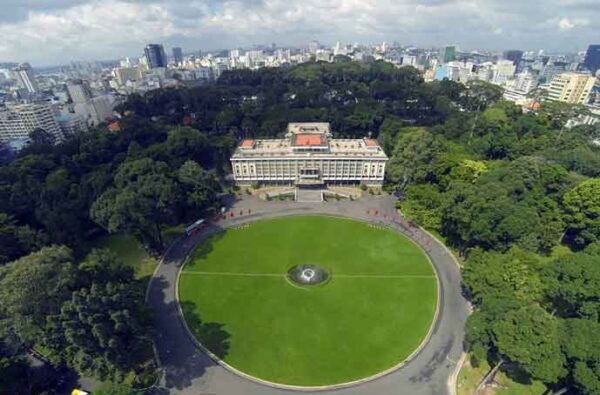
Reunification Palace from above-Ho Chi Minh City.
The Architectural Charm of Reunification Palace
The design of Reunification Palace is a captivating blend of traditional Vietnamese symbolism and 1960s modernist aesthetics. While its exterior may seem understated, the thoughtful details woven into its structure reveal a deeper cultural narrative. Architect Ngo Viet Thu incorporated elements of Vietnamese cosmology, with features like symmetrical layouts and symbolic column arrangements evoking prosperity and balance.
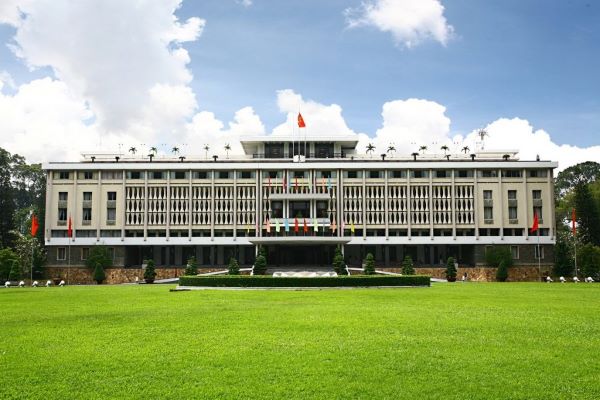
Reunification Palace (formerly known as Independence Palace).
Inside, the palace is a time capsule of mid-20th-century design. Grand meeting rooms adorned with ornate furnishings, retro furniture, and elegant decor transport visitors back to the era of South Vietnam’s presidency. The basement, with its labyrinth of tunnels and wartime operation rooms, offers a stark contrast, revealing the strategic underbelly of the war effort. The rooftop terrace, scarred by the 1975 bombing, provides sweeping views of Ho Chi Minh City, adding another layer to the palace’s allure.
Exploring the Palace’s Highlights
Walking through Reunification Palace feels like stepping into a living history book. The war command room, filled with vintage maps, radios, and typewriters, offers a glimpse into the strategic planning of the Vietnam War. Out on the grounds, the iconic tank and fighter plane stand as reminders of the war’s final days. The basement tunnels, with their narrow corridors and wartime relics, evoke the tension of the era.
The presidential quarters, with their lavish decor, showcase the opulence of South Vietnam’s leadership. Meanwhile, the state banquet halls reflect the grandeur of diplomatic gatherings. For a unique perspective, the rooftop terrace not only bears the marks of history but also offers a sprawling cityscape. English-guided tours are available, providing deeper insights into the palace’s significance and stories.
Why Reunification Palace is a Must-Visit
Reunification Palace is more than a historical site; it’s a testament to Vietnam’s journey from division to unity. Whether you’re drawn to its historical weight, architectural intrigue, or cultural resonance, the palace delivers a rich experience. Its preserved rooms, wartime artifacts, and symbolic legacy make it an essential stop for anyone exploring Ho Chi Minh City.
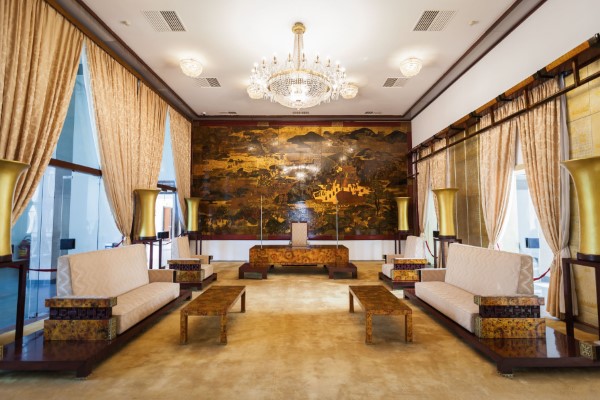
Reunification Palace interior.
To extend your adventure, consider visiting nearby attractions like the War Remnants Museum, which offers further context on the Vietnam War, or the Saigon Central Post Office, a stunning example of French colonial architecture. Ben Thanh Market, a hub for local street food and souvenirs, and the elegant Notre-Dame Cathedral are also within easy reach, making it simple to craft a full day of exploration.
Visitor Information for Reunification Palace
Location and How to Get There
Reunification Palace is centrally located at 135 Nam Ky Khoi Nghia Street, District 1, Ho Chi Minh City, at the end of Le Duan Street. It is surrounded by Huyen Tran Cong Chua Street, Nguyen Thi Minh Khai Street, and Nguyen Du Street, making it easily accessible.
- By Taxi or Rideshare: Taxis and apps like Grab and XanhSM are convenient and affordable.
- By Motorbike: Renting a motorbike is a popular option for navigating the city.
- On Foot: If you’re staying in District 1, the palace is within walking distance from other attractions like Notre-Dame Basilica or Ben Thanh Market.
Opening Hours and Tickets
- Hours: Open daily from 8:30 AM to 4:30 PM.
- Entrance Fee: Approximately VND 65,000 (~$2.5 USD) for adults. Prices may vary for children or guided tours.
- Guided Tours: English-speaking guides are available for a small additional fee, offering in-depth historical context.
Planning Your Visit to Reunification Palace
Reunification Palace in Ho Chi Minh City is a destination that resonates with history, culture, and resilience. From its war-scarred basement to its elegant presidential suites, every corner tells a piece of Vietnam’s story. For travelers seeking to connect with the nation’s past, this landmark offers an unforgettable experience. Plan your visit, step through its gates, and discover the legacy of a nation that forged unity from conflict.
Embark on your Ho Chi Minh City tours with Paradise Travel and let us guide you through Vietnam’s remarkable history.

